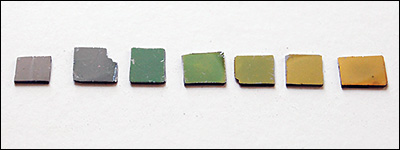 |

Novel gold-nanoparticle SERS substrates. By controlling the size and spacing between nanoparticles that self-arrange into patterns on the surface of the substrate, the color of the light absorbed or reflected by the substrate is tuned. This nanoscale architecture of the substrates is optimized to enhance their interaction with the probing laser light and the chemicals to be detected.
Clark School Department of Materials Science and Engineering (MSE) associate professor Oded Rabin has received a $50,000 research gift from Agilent Technologies' University Relations Program. The gift will support his exploration of engineered nanoparticle arrays used to boost the capabilities of surface-enhanced Raman spectroscopy (SERS), a powerful sensing technique that determines the presence, amount and identity of chemicals in a sample by the way light from a laser scatters when shined on it. Rabin will collaborate with MSE professor and chair Robert M. Briber and Agilent scientist Dr. Miao Zhu on the project.
The "surface" in "SERS" is an extra component, typically a metal-coated wafer of silicon or glass. This substrate focuses and intensifies the light from the system's laser probe, boosting its ability to detect target materials in trace quantities as small as a few thousand molecules. Rabin's research group has been developing novel, more effective SERS substrates for the past few years. In this case, the substrates consist of billions of gold nanoparticles arranged in a hexagonal pattern over a silicon wafer.
"Our substrates are exceptional in three ways," Rabin explains. "First, they are fabricated by self-assembly, providing a significant cost benefit. Second, they produce a strong, consistent signal across their entire area—this is of considerable importance as the lack of reproducibility has stalled the transition of SERS from academic settings to real-world diagnostics for decades. Third, the plasmon modes of our substrates' nanostructures can be adjusted to match any given Raman spectrometer that uses a laser excitation in the visible or the near infrared range. This is achieved by changing a single parameter in the fabrication process, with predictable and repeatable results."
"The gift from Agilent Technologies will support our efforts to improve this technology and demonstrate its adaptability to market needs," says Briber. "Our work will help design high-throughput assays that best utilize the virtues of the SERS substrates and account for their limitations."
Rabin and Briber hope the collaboration will blossom into a partnership in which Agilent, a manufacturer of measurement and analysis systems, will be able to utilize the new substrate technology in the production of spectroscopy devices and substrate kits.
Related Articles:
"Pocket Change Spectroscopy" Improves Detection of Toxins, Explosives
August 13, 2013
|